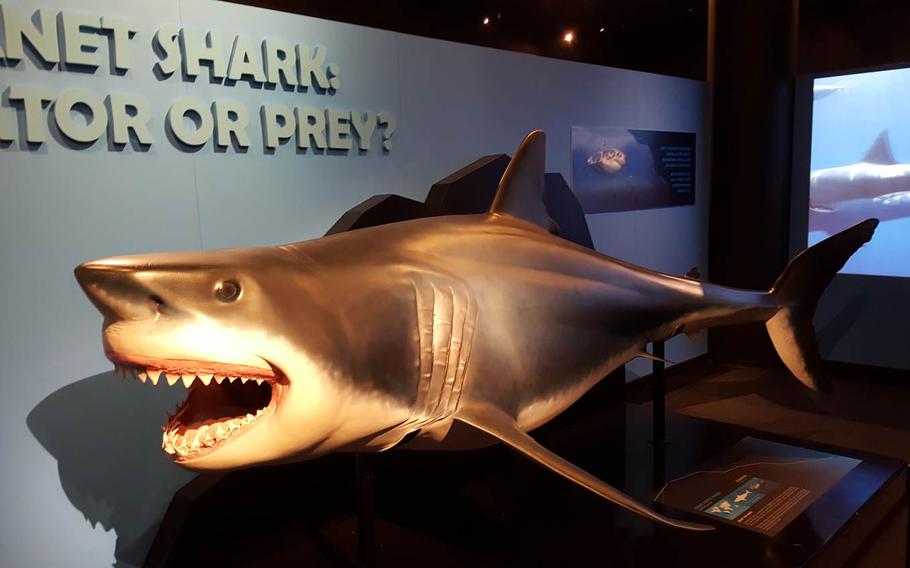
The not-so-subtle message of Planet Shark: Predator or Prey, an exhibit at the Bishop Museum in Honolulu, is that while this ancient creature is at the top of the ocean food chain, sea life would collapse without sharks playing their role. (Wyatt Olson/Stars and Stripes)
Most of our understanding of sharks comes from works of fiction, such as the “Jaws” or “Sharknado” movies. In other words, they’re villains. And then there’s the occasional story of a surfer in the wrong place at the wrong time.
The not-so-subtle message of “Planet Shark: Predator or Prey,” an exhibit at the Bishop Museum in Honolulu, is that while this ancient creature is at the top of the ocean food chain, sea life would collapse without sharks playing their role. And their villainous reputation is a bad rap.
The exhibit is kid-friendly, with several hands-on displays and a kiosk for tracing the outlines of various types of sharks. One display allows children to assemble the pieces of a shark in a puzzle.
The main hall has been converted into a massive multiscreen theater, with undersea video of sharks projected floor to ceiling — and on a part of the floor. The setup gives viewers a sense of being underwater with sharks jetting left and right.
The series of short videos features different species: blue shark, tiger shark, bull shark, hammerhead, great white and others.
One clip shows an astounding shark feeding frenzy on a vast school of baby mackerel. The school does its best to elude the predators, as tens of thousands of them zig-zag in a futile ballet of escape.
Sharks have evolved relatively little during the past 16 million years, according to the exhibit. Some species are basically the same as they were 200 million years ago. Sharks predate dinosaurs, insects and mammals.
Their secret to survival has been the ability to adapt their hunting in deep sea, shallow water, rivers and reefs. The bull shark can live in both saltwater and fresh water.
There are more than 440 known species of sharks, with more yet to be discovered. The whale shark claims the title of both largest shark and largest fish in the world.
Getting back to the villainy of sharks: Yes, they are a top predator of the sea, but the threat they pose to people is relatively low. How rare are attacks on humans?
From the exhibit: “More people died in 2015 taking selfies than were killed by sharks.”
Cows kill an average of 22 people in the United States each year; mosquito-borne diseases kill a million people a year; about 25 people die in saunas annually; falling coconuts take the lives of about 150 people each year; roughly 450 die each year after falling out of bed.
Shark attacks kill an average of four people a year.
That doesn’t mean there aren’t some common-sense things to be done to avoid attracting this toothy predator. The exhibit offers some eminently practical advice: avoid water at dusk and dawn, avoid waters where sharks have been seen and don’t get in the water if you’re bleeding.
Also, don’t buy into the myth that the presence of dolphins means sharks aren’t about. They both like to eat the same things and are drawn to similar waters.
On display is a military jumpsuit that includes a packet of Shark Chaser, a repellent developed by the U.S. military during World War II to be carried in the lifejackets of airmen and sailors. Shark Chaser was used by the military until 1975, but it “did little to repel sharks” and was more a “morale booster” than effective deterrent, the exhibit said.
In recent decades, sharks have had far more to fear from humans than vice versa. The demand for shark fins by some Asian countries has led to mass slaughter, whereby the fins are cut off and the dead sharks are dumped back into the water.
A 2013 study published in the journal Marine Policy estimated 97 million sharks were killed through fishing in 2010 — intentionally or not. The kill rate is beyond the so-called “rebound rate” for births to maintain many shark populations.
“The consequences of these unsustainable catch and mortality rates for marine ecosystems could be substantial,” the study said. “Global total shark mortality, therefore, needs to be reduced drastically in order to rebuild depleted populations and restore marine ecosystems with functional top predators.”
After eons of unchanged dominance, sharks are now the prey.
Planet Shark: Predator or Prey
DIRECTIONS
See “Planet Shark: Predator or Prey” at 1525 Bernice St., Honolulu, Hawaii; Bernice Pauahi Bishop Museum, Castle Memorial Building, first floor.
TIMES
9 a.m. to 5 p.m. daily through Sept. 5
COSTS
$22.95 adults; $19.95 adults with military ID; $19.95 seniors; $14.95 ages 4-12; free for ages 3 and younger. Parking in the museum lot is $5 per car. INFORMATION
Photography and videography are ballowed. (808) 847-3511; www.bishopmuseum.org/exhibits